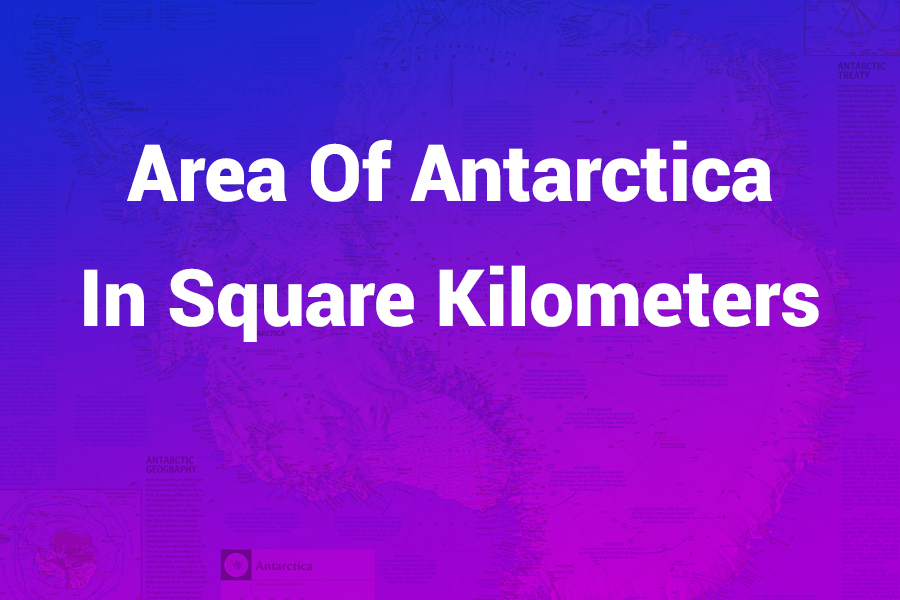Antarctica isn’t just the coldest continent—it also ranks among the largest by surface area. Understanding its precise size helps in assessing climate impacts, sea-level risks, and global geography.
In this article you’ll learn the best current estimates of Antarctica’s area in square kilometers, how ice shelves affect that number, seasonal changes in sea ice, comparisons with other continents, and the significance of changes over time in this massive frozen realm.
Antarctica’s Total Area
The most accepted figure for Antarctica’s total surface area is approximately 14,200,000 square kilometers. This includes the continental landmass plus its floating ice shelves and peripheral islands. That converts to about 5.48 million square miles.
If we remove the floating ice shelves and focus strictly on grounded ice plus the rock base (i.e. the “footprint” of the continent without its shelf extensions), the area drops to around 12,300,000 square kilometers, or roughly 4.8 million square miles.
Thus, whether you include or exclude the ice shelves can shift your estimate by nearly 1.9 million square kilometers.
Why the Discrepancy? Ice Shelves and Islands
Antarctica’s “true” border can be ambiguous. Ice shelves are portions of ice that extend over the ocean but remain attached to land. They are often considered part of the continent in broad area estimates. About 11 percent of the total “Antarctic” area is attributed to these floating ice shelves.
Islands and outlying rocky features also factor in. Many continental maps include peripheral islands when quoting the 14.2 million km² figure. Excluding those features shrinks the area somewhat.
Seasonal Sea Ice Changes
Unlike permanent ice, sea ice grows and shrinks with seasonal temperature cycles. At the end of Antarctic summer (around February), the sea ice contracts to as little as 1.8 to 2.5 million square kilometers. During the southern hemisphere winter, that expanding ice can surround the continent and reach ~19 million square kilometers—far exceeding the continental core itself.
Those fluctuations do not alter the permanent landmass number, but they influence the apparent “ice-covered area” at any moment.
Context through Comparison
Putting Antarctica’s size into perspective helps:
- It’s larger than Australia (7.7 million km²) by nearly double.
- It’s comparable to the combined size of the continental U.S. and Mexico.
- Europe, at ~10 million km², is significantly smaller.
- If reduced to just its grounded area (12.3 million km²), Antarctica still outpaces many major continents.
So when you hear “14.2 million km²,” understand that this includes the dynamic ice shelf zone.
Breakdown by Region
The continent splits roughly into East Antarctica and West Antarctica, separated by the Transantarctic Mountains. East Antarctica is vastly larger and holds most of the area and ice volume.
One notable region is Marie Byrd Land, a vast unclaimed territory in West Antarctica, covering about 1,610,000 square kilometers on its own.
Why Precise Area Matters
Accurate measurements matter for more than trivia:
- Sea-level rise models: Knowing how much grounded ice exists helps scientists estimate how much water could enter the oceans if melting accelerates.
- Climate modeling: Ice extent and mass feed into global climate models and affect atmospheric and oceanic circulation.
- Legal and treaty boundaries: Under the Antarctic Treaty System, precise definitions of territorial zones matter for research claims and environmental protections.
Recent Trends & Data
In recent years, satellite mapping and elevation modeling (e.g. the Reference Elevation Model of Antarctica) have refined our understanding of subtle changes in ice thickness and extent. The continent’s gross area remains stable, but internal mass distribution is shifting: ice is thinning in some regions and thickening in others.
Annual sea ice minimums have recently dipped close to historic lows—around 1.87 million km² in February 2025, for instance. That highlights how transient ice affects only the peripheral area, not the core continental footprint.
Key Figures Recap
| Measure | Estimate (km²) | Notes |
| Total (land + ice shelves + islands) | ~14,200,000 | Commonly cited “Antarctica area” |
| Grounded continent footprint | ~12,300,000 | Excludes floating ice shelves |
| Seasonal sea ice (summer minimum) | ~1,800,000–2,500,000 | Varies year to year |
| Seasonal sea ice (winter maximum) | ~19,000,000 | Surrounding sea ice extent |
Challenges in Measurement
Measuring Antarctica is complex. Ice thickness, surface slopes, and bedrock depression influence calculations. Some areas lie below sea level but are overlain by thick ice. Meltwater flows beneath the ice, shifting mass distributions. Researchers must calibrate satellite altimetry, radar, and gravity data to obtain accurate area and volume metrics.
Also, floating ice shelves gradually calve off or restructure, which changes the outline used in area calculations. So area estimates are snapshots that require periodic updates with advanced remote sensing.
Implications for Climate & Sea Levels
The grounded ice sheet holds the potential to raise global sea level by roughly 50 to 60 meters if fully melted—though that scenario would unfold over many centuries. As warming accelerates, parts of West Antarctica appear more vulnerable to destabilization than East Antarctica due to steeper slopes and warmer ocean incursions.
Loss of ice may also reshape Earth’s mass distribution and subtly affect the planet’s rotation, gravity anomalies, and geoid shape—factors that matter for geodesists and climate scientists.
Conclusion
Antarctica spans about 14.2 million square kilometers when including its ice shelves and islands, with a core grounded footprint of about 12.3 million square kilometers. Seasonal sea ice adds dramatic expansion and contraction—yet it does not alter the permanent continental area.
These figures matter deeply for science, climate policy, and our understanding of Earth’s systems. With ongoing satellite improvements, we’ll continue refining these numbers and tracking how the Antarctic environment evolves.

